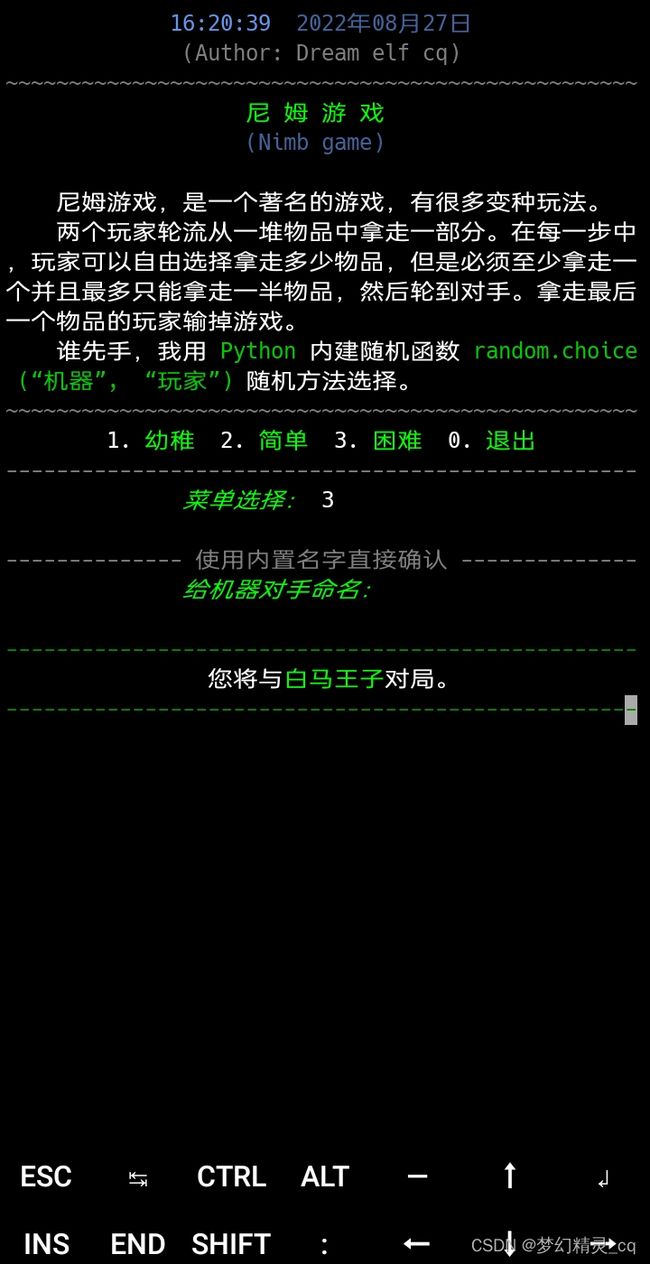彩色文字界面尼姆游戏(Python类 + mypycolor 工具协作打造)
Python 官网:https://www.python.org/
-
Free:大咖免费“圣经”教程《 python 完全自学教程》,不仅仅是基础那么简单……
- My CSDN主页、My HOT博、My Python 学习个人备忘录
- 好文力荐、 老齐教室
自学并不是什么神秘的东西,一个人一辈子自学的时间总是比在学校学习的时间长,没有老师的时候总是比有老师的时候多。
—— 华罗庚
- 尼姆游戏(彩色文字界面版)(2022-08-26)
- 尼姆游戏(优化版)(2021-12-08)
- 尼姆游戏(首发)(2021-11-30)
-
- “LJXFRUITMAN”给找到bug
-
- 引发我重写彩色界面版
-
- 函数式编程
-
- 机器聪明
-
- 游戏“困难模式”效果
-
- 游戏完整源码
“LJXFRUITMAN”给我前面记的笔记《尼姆游戏(优化版)》(2021-12-08)找到一个bug,困难模式下都是机器先手,“真人”没有赢的可能。
笔记评论截屏图片
激发我重写彩色文字界面版
在修复bug的时候,感觉到尼姆游戏(优化版)“代码还有很大优化空间,逻辑也有些许混乱”,这是由于当时“基础还不太熟”。看着“灰白”的文字界面,又想起前不久完成优化的色彩控制工具mypycolor,就想要用渐渐熟悉起来的class + mypyolor协同打造彩色文字界面版“尼姆游戏”。文字界面也用最近沉淀的“技巧”,打造一个固定不变的界面header。经过一番努力尝试,header还嵌入“尼姆游戏”的规则。
header代码
def clear(): clear = system('clear') # Linux清屏。
class Nimb:
readme = f"\n{'':>13}{localtime_show()}\n{color('(Author: Dream elf cq)'.center(50), 30, 100, 7)}{color('~'*50, 30, 100, 7)}\n{color('尼 姆 游 戏'.center(46), 92)}\n{color('(Nimb game)'.center(50), 34, 2)}\n\n{'':>4}尼姆游戏,是一个著名的游戏,有很多变种玩法。\n{'':>4}两个玩家轮流从一堆物品中拿走一部分。在每一步中,玩家可以自由选择拿走多少物品,但是必须至少拿走一个并且最多只能拿走一半物品,然后轮到对手。拿走最后一个物品的玩家输掉游戏。\n{'':>4}谁先手,我用{color(' Python ', 32)}内建随机函数{color(' random.choice (“机器”, “玩家”) ', 32)}随机方法选择。\n{color('~'*50, 30, 100, 7)}"
def head(self): # 打印游戏规则及说明。
clear()
print(self.readme)
函数式编程
我决定用“函数式编程”来结构我的Nimb game,我用 class Nimb: 组织代码,每个方法完成一个“小功能”,最后直接“组装”。
help(Nimb)得到的 class Nimb: 方法清单

游戏主模块play代码
def play(self, rank=(0,)): # 游戏取物主模块,默认“幼稚”级别。
computer_name = self.name_computer()
player = choice(('您', computer_name))
rank = list(rank)
while True:
self.clear()
if player == computer_name:
shuffle(rank) # 打乱待选机率列表。
way = choice(rank)
if way == 0:
take = self.random_take()
elif way == 1:
take = self.clever_take()
input(f"{'':>14}机器取物:{color(take, 92)}")
self.num = self.num - take
player = '您' # 当前玩家切换。
else:
take = self.person_take()
self.num = self.num - take
player = computer_name # 当前玩家切换。
if not self.num:
break
self.iswin(player)
游戏“真人取物”模块person_take代码
def person_take(self): # 真人玩家取物。
self.clear()
while True:
try:
take = int(input(f"{'':>14}{color('您取物: ', 92, 3)}"))
if take > self.num or take < 1 or self.num > 1 and take > int(self.num/2):
error_show('取物')
self.clear()
continue
except Exception as error:
print(f"ErrorType: {color(error, 31)}")
error_show('输入')
self.clear()
continue
break
return take
机器聪明取物
机器聪明取物代码
def clever_take(self): # 机器聪明取物。
self.clear()
num = self.num
for i in range(num): # 注意:三个 if 顺序不可以变动!首先检查物品现存数为1~3或者2的幂次方少1的情况。1~3,只能取1,后者取1,才是必胜局。再检查必输局的情况。现存物品数为2的幂次方少1,随机取物,期待对手疏漏。最后是“聪明”正常取物,取物后让现存物品数为2的幂次方少1,造就必胜局。
if 2**i == num or num < 4:
return 1 # 当物品现存数为2的幂次方或者小于4时,只取1。
elif 2**i - 1 == num:
return choice(range(1, int(num/2))) # 当物品现存数为2的幂次方少1时,是必输局,随机取物。
elif 2**i > num:
return num - (2**(i-1)-1) # 让取物后现存物品数为2的幂次方少1,呈必胜局。
注意:
- 1、首先检查物品现存数为1~3或者2的幂次方少1的情况。1~3,只能取1,后者取1,才是必胜局。
- 2、再检查必输局的情况。现存物品数为2的幂次方少1,随机取物,期待对手疏漏,截取翻身机会。
- 3、最后是“聪明”正常取物,取物后让现存物品数为2的幂次方少1,造就必胜局。
游戏“困难模式”效果
游戏部分效果截屏图片
游戏完整源码跳过源码
#/sur/bin/nve python
# coding: utf-8
'''
filename = 'nimb_game.py'
author = 'dream elf cq'
time = '2002-08-24'
'''
from os import system # 加载python命令运行“容器”os.system方法。
from random import choice # 加载random模块choice随机选择方法。
from random import shuffle # 加载random模块shuffle洗牌方法。
from time import localtime # 加载当前时间数组获取方法。
from lib.mypycolor import Color # 加载自制色彩控制打印工具。
color = Color().set_color # 方法别名,方便调用。
def clear(): clear = system('clear') # Linux清屏。
def localtime_show(): # 获取当前时间格式化字符串。
t = localtime()
time = ':'.join(map(lambda x: f"{x:0>2}", t[3:6]))
year, month, day = t[:3]
date = f"{year}年{month:0>2}月{day:0>2}日"
return f"{color(time, 34)} {color(date, 34, 2)}"
def error_show(string): # 错误提示。
tip = f" {string}错误!".center(45, '~')
input(f"{color(tip, 91, 43)}\n")
class Nimb:
'''
尼 姆 游 戏 (Nimb game) 尼姆游戏,这是一个著名的游戏,有很多变种玩法。
两个玩家轮流从一堆物品中拿走一部分。在每一步中,玩家可以自由选择拿走多少物品,但是必须至少拿走一个并且最多只能拿走一半物品,然后轮到对手。拿走最后一个物品的玩家输掉游戏。
谁先手,我用 Python 内建随机函数 random.choice (“机器”, “玩家”) 随机方法选择。
(Author: Dream elf cq)
'''
readme = f"\n{'':>13}{localtime_show()}\n{color('(Author: Dream elf cq)'.center(50), 30, 100, 7)}{color('~'*50, 30, 100, 7)}\n{color('尼 姆 游 戏'.center(46), 92)}\n{color('(Nimb game)'.center(50), 34, 2)}\n\n{'':>4}尼姆游戏,这是一个著名的游戏,有很多变种玩法。\n{'':>4}两个玩家轮流从一堆物品中拿走一部分。在每一步中,玩家可以自由选择拿走多少物品,但是必须至少拿走一个并且最多只能拿走一半物品,然后轮到对手。拿走最后一个物品的玩家输掉游戏。\n{'':>4}谁先手,我用{color(' Python ', 32)}内建随机函数{color(' random.choice (“机器”, “玩家”) ', 32)}随机方法选择。\n{color('~'*50, 30, 100, 7)}"
computer_names = ('小精灵', '小阔爱', '小乖乖', '小王子', '小仙女', '观音大士', '女神', '重庆崽儿', '梦幻精灵cq', '八爪章鱼', '齐天大圣', '皇阿玛', '小燕子', '小傻瓜', '红苕花', '白马王子')
model = ''
num = ''
def head(self): # 打印游戏规则及说明。
clear()
print(self.readme)
def num_show(self): # 打印游戏模式及现在物品数量。
model = f"【{self.model}模式】".center(44, '-')
print(f"\n{color(model, 92)}\n\n{'':>14}现存物品数:{color(self.num, 92)}\n{color('-'*50, 30, 100, 7)}")
def clear(self): # 打印游戏界石头部信息及现存物品数量。
self.head()
self.num_show()
def person_take(self): # 真人玩家取物。
self.clear()
while True:
try:
take = int(input(f"{'':>14}{color('您取物: ', 92, 3)}"))
if take > self.num or take < 1 or self.num > 1 and take > int(self.num/2):
error_show('取物')
self.clear()
continue
except Exception as error:
print(f"ErrorType: {color(error, 31)}")
error_show('输入')
self.clear()
continue
break
return take
def random_take(self): # 机器随机取物。
if self.num < 4: take = 1
else:
take = choice(range(1, int(self.num/2)+1))
return take
def clever_take(self): # 机器聪明取物。
self.clear()
num = self.num
for i in range(num): # 注意:三个if顺序不可以变动!首先检查物品现存数为1~3或者2的幂次方少1的情况。1~3,只能取1,后者取1,才是必胜局。再检查必输局的情况。现存物品数为2的幂次方少1,随机取物,期待对手疏漏。最后是“聪明”正常取物,取物后让现存物品数为2的幂次方少1,造就必胜局。
if 2**i == num or num < 4:
return 1 # 当物品现存数为2的幂次方或者小于4时,只取1。
elif 2**i - 1 == num:
return choice(range(1, int(num/2))) # 当物品现存数为2的幂次方少1时,是必输局,随机取物。
elif 2**i > num:
return num - (2**(i-1)-1) # 让取物后现存物品数为2的幂次方少1,呈必胜局。
def menu_show(self): # 游戏菜单展示。
self.head()
print(' '*8, end='')
print(' '.join(map(lambda x,y: f"{x}. {color(y, 92)}", list('1230'), ('幼稚', '简单', '困难', '退出'))))
print(color('-'*50, 30, 100, 7))
def name_computer(self): # 机器对手名字设定。
computer_name = input(f"\n{color(' 使用内置名字直接确认 '.center(40, '-'), 30, 100, 7)}\n{'':>14}{color('给机器对手命名:', 92, 3)}").strip()
if not computer_name:
computer_name = choice(self.computer_names)
input(f"\n{color('-'*50, 32, 2)}\n{'':>16}您将与{color(computer_name, 92)}对局。\n{color('-'*50, 32, 2)}")
return computer_name
def iswin(self, winer): input(f"\n{color('-'*50, 33, 2)}\n{'':>20}{color(winer + ' ', 92, 3)}{color('赢了!', 91, 43, 5)}\n{color('-'*50, 2, 33)}\n") # 打印赢家。
def play(self, rank=(0,)): # 游戏取物主模块,默认“幼稚”级别。
computer_name = self.name_computer()
player = choice(('您', computer_name))
rank = list(rank)
while True:
self.clear()
if player == computer_name:
shuffle(rank) # 打乱待选机率列表。
way = choice(rank)
if way == 0:
take = self.random_take()
elif way == 1:
take = self.clever_take()
input(f"{'':>14}机器取物:{color(take, 92)}")
self.num = self.num - take
player = '您' # 当前玩家切换。
else:
take = self.person_take()
self.num = self.num - take
player = computer_name # 当前玩家切换。
if not self.num:
break
self.iswin(player)
def naive(self): # 幼稚级别游戏模块。
self.model = '幼稚'
self.num = choice(range(1, 201))
self.play()
def easy(self): # 简单级别游戏模块,36%机率机器“聪明”取物。
self.model = '简单'
self.num = choice(range(201, 501))
self.play(([1]*36 + [0]*64))
def hard(self): # 困难级别游戏模块,92%机率机器“聪明”取物。
self.model = '困难'
self.num = choice(range(501, 1501))
self.play([0]*8 + [1]*92)
def ismenu(self): # 菜单确认,据菜单选择,执行相应游戏模块。
while True:
self.menu_show()
try:
menu_choice = int(input(f"{'':>14}{color('菜单选择: ', 92, 3)}"))
if menu_choice not in range(4):
error_show('选取')
self.clear()
continue
except Exception as error:
print(f"ErrorType: {color(error, 31)}")
error_show('输入')
self.clear()
continue
break
if menu_choice == 0:
self.head()
print(f"\n{'':>14}{color('谢谢您体验“尼姆游戏”!', 95, 3)}\n{color('~'*50, 30, 100, 7)}\n{color('Author: Dream Elf cq, Tester: Liuyi'.center(50), 34, 2)}\n{color('-'*50, 30, 100, 7)}\n")
exit()
elif menu_choice == 1:
self.naive()
elif menu_choice == 2:
self.easy()
elif menu_choice == 3:
self.hard()
def start(self): # 游戏主循环模块。
while True:
self.ismenu()
if __name__ == '__main__': # 直接运行本*.py文件,则启动游戏。
Nimb().start()
__上一篇:__ 单词记忆系统三:优化音标输入(允许键盘直接输入和音标序号混合输入)
__下一篇:__ 文本模式打印彩色直方统计图
我的HOT博:
- Hot:回车符、换行符和回车换行符(1002阅读)
- Hot:Linux 脚本文件第一行的特殊注释符(井号和感叹号组合)的含义(1017阅读)
- pandas 数据类型之 Series(1099阅读)
- 聊天消息敏感词屏蔽系统(字符串替换 str.replace(str1, *) )(1226阅读)
- 练习:银行复利计算(用 for 循环解一道初中小题)(1111阅读)
- pandas 数据类型之 DataFrame(1765阅读)
- Hot:班里有人和我同生日难吗?(蒙特卡洛随机模拟法)(2125阅读)
- Python字符串居中显示(1792阅读)
- 练习:求偶数和、阈值分割和求差( list 对象的两个基础小题)(1660阅读)
- 用 pandas 解一道小题(1988阅读)
- 可迭代对象和四个函数(1078阅读)
- “快乐数”判断(1245阅读)
- 罗马数字转换器(构造元素取模)(1984阅读)
- Hot:罗马数字(转换器|罗生成器)(4302阅读)
- Hot:让QQ群昵称色变的代码(33047阅读)
- Hot:斐波那契数列(递归| for )(4060阅读)
- 柱状图中最大矩形(1661阅读)
- 排序数组元素的重复起止(1253阅读)
- 电话拨号键盘字母组合(1380阅读)
- 密码强度检测器(1889阅读)
- 求列表平衡点(1827阅读)
- Hot: 字符串统计(4299阅读)
- Hot:尼姆游戏(聪明版首发)(3459阅读)尼姆游戏(优化版)(1074阅读)
推荐条件 点阅破千
精品文章:
- 好文力荐:《python 完全自学教程》齐伟书稿免费连载
- OPP三大特性:封装中的property
- 通过内置对象理解python'
- 正则表达式
- python中“*”的作用
- Python 完全自学手册
- 海象运算符
- Python中的 `!=`与`is not`不同
- 学习编程的正确方法
来源:老齐教室
Python 入门指南【Python 3.6.3】
好文力荐:
-
全栈领域优质创作者——寒佬(还是国内某高校学生)好文:《非技术文—关于英语和如何正确的提问》,“英语”和“会提问”是学习的两大利器。
-
【8大编程语言的适用领域】先别着急选语言学编程,先看它们能干嘛
-
靠谱程序员的好习惯
CSDN实用技巧博文:
- 8个好用到爆的Python实用技巧
- python忽略警告
- Python代码编写规范
- Python的docstring规范(说明文档的规范写法)



